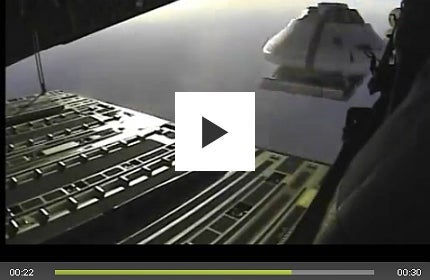
When Nasa’s space shuttle made its last descent to Earth in 2011, the end of one era promised to herald something new. In the pursuit of a better understanding of space and space travel, the shuttle had drained billions of dollars in resources and a new Nasa, shaped by economic constraints and fiscal policy, was forced into examining a more frugal option.
Orion was conceptualised, and continues to edge closer to its first launch into space.
Although originally part of the now-cancelled Constellation programme, Orion, a multipurpose crew vehicle (MPCV), is currently being constructed by Lockheed Martin to fill the void left by the departed space shuttle. The vehicle itself is not planned to carry astronauts into space until after 2020, but rigorous testing procedures are now well under way.
Testing now under way
Environmental testing on Orion was conducted from 2007 to 2011 at Glenn Research Center’s Space Power Facility in Sandusky, Ohio, while a series of six Abort Test Flights (ATF) were carried out between 2008 and 2011 at the US Department of Defense’s White Sands Missile Range in New Mexico.
How well do you really know your competitors?
Access the most comprehensive Company Profiles on the market, powered by GlobalData. Save hours of research. Gain competitive edge.

Thank you!
Your download email will arrive shortly
Not ready to buy yet? Download a free sample
We are confident about the unique quality of our Company Profiles. However, we want you to make the most beneficial decision for your business, so we offer a free sample that you can download by submitting the below form
By GlobalDataThe first ATF, held on 20 November 2008, marked the first time a motor with reverse flow propulsion technology capable of providing 500,000lb of thrust had been tested.
The vehicle’s most recent testing, conducted in December 2012, focused on the capsule’s ability to return safely to Earth. During actual spaceflight, Orion will return to Earth at speeds faster than any previous human spacecraft, forcing a great deal of reliance on parachutes to effectively slow the capsule’s descent.
Testing saw a mock-up capsule dropped from an aircraft 25,000 feet above the US Army’s Yuma Army Proving Grounds in Arizona, US.
Future milestones
With Orion making steady progress, a number of key milestones have begun to appear on the horizon. In August 2013, the first key Orion recovery test will take place at Naval Station Norfolk in Virginia, trialling a number of new technologies that have been developed by Nasa to aid in the recovery of the capsule from the water. A second recovery test is scheduled for January 2014 at Navy Base San Diego.
All testing leading up to that point will culminate in the first test in the programme’s development stage, scheduled to blast off in September 2014.
Exploration Flight Test-1 will see the MPCV, attached to a Delta IV rocket, orbit the Earth twice before re-entering the atmosphere at approximately 20,000mph.
The success of this test is crucial to Nasa’s hope of sending a crew of four on a ten to 14 day mission between 2019 and 2021.
With a number of companies racing to usher in the era of Space Tourism, Orion represents the next stage of meaningful discovery in space for Nasa. Orion, when launched from Nasa’s in-development Space Launch System, could eventually support a manned journey to Mars, representing an enormous leap in human discovery.
Related content
Is Nasa’s Space Fence the solution to space debris?
As Nasa scrambles to move the International Space Station out of harm’s way, efforts are being made to monitor space junk.
The most advanced manned space programmes
In the vacuum left by the now defunct space shuttle programme, several new and emerging manned spacecraft are being developed to explore the universe.



